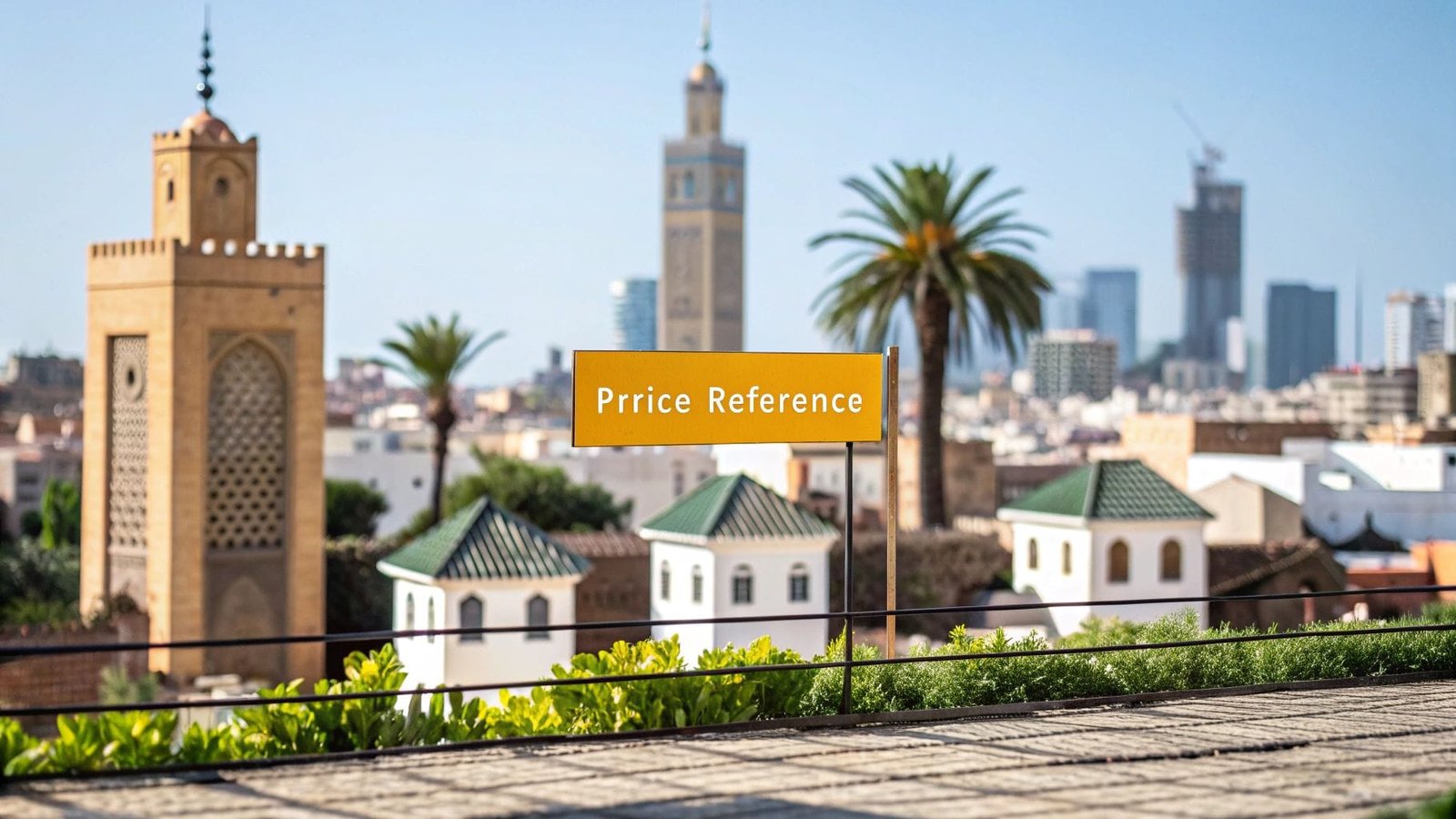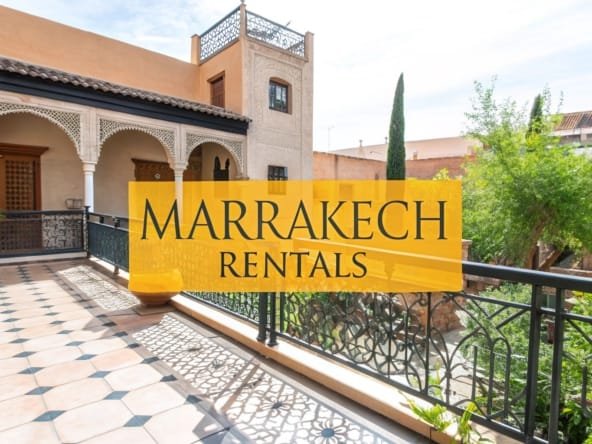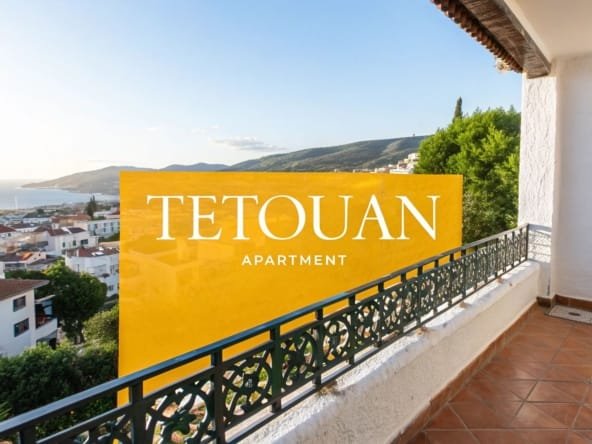Ever thought how helpful it would be to have an official price guide before buying or selling property in Morocco? That's precisely what the referentiel prix immobilier is. Think of it as a government-backed benchmark, created to make sure property deals are valued fairly, especially when it comes to taxes.
For anyone dipping their toes into the Moroccan real estate market, getting to grips with this system isn't just helpful—it's essential.
What Is the Real Estate Price Reference?

At its core, the referentiel prix immobilier is a baseline price list for properties, broken down by city and even neighbourhood across Morocco. It’s published by the General Tax Directorate (DGI) and sets a minimum value for any real estate transaction. The main goal? To bring transparency to the market and stop people from under-declaring a property's sale price to dodge taxes.
This benchmark isn’t just a number pulled out of thin air. It’s carefully calculated based on a history of actual sales data from that specific area. For the government, it's a safety net to ensure the right amount of registration tax is paid on every sale. If a property sells for a price below the official reference, tax authorities can—and will—adjust the taxable value up to the benchmark price.
Why It Matters to You
Whether you're a buyer, seller, or investor, this tool is much more than a bureaucratic detail. It offers a solid, data-backed starting point for property valuation, adding a much-needed layer of predictability to what can be a very fluid market. Frankly, you can't afford to ignore it if you want to make smart financial moves.
The price reference acts as a crucial anchor in negotiations. It gives both the buyer and the seller a shared, objective valuation to start from, which helps cut down on disagreements and leads to fairer deals for everyone.
Trying to navigate the Moroccan property scene without checking this guide is like setting sail without a compass. It gives you the power to:
- Validate asking prices: As a buyer, you can quickly see if a seller's price is grounded in reality or is overly optimistic.
- Set competitive offers: As a seller, you can price your property in a way that’s realistic, attracting genuine buyers without leaving money on the table.
- Negotiate with confidence: Armed with official data, both sides can argue their positions far more effectively.
To give you a clearer picture, let's break down the key elements of this reference guide.
Key Components of the Real Estate Price Reference
| Component | What It Is | Why It Matters |
|---|---|---|
| Official Benchmark | A minimum property value set by the General Tax Directorate (DGI). | Ensures transactions are valued fairly for tax purposes. |
| Data-Driven Calculation | Based on historical sales data from specific neighbourhoods. | Provides an objective, fact-based valuation, not just guesswork. |
| Tax Assessment Tool | The DGI uses it to calculate the minimum registration tax due on a sale. | Prevents tax evasion and ensures the state collects its fair share. |
| Negotiation Anchor | A neutral starting point for price discussions between buyers and sellers. | Reduces disputes and helps both parties reach a fair agreement faster. |
Understanding these components is the first step toward using the reference guide to your advantage.
This guide will walk you through exactly how the reference is calculated, why prices vary so much from one region to another, and how you can use it in practice. To see a real-world example, take a look at our in-depth analysis of the referentiel prix immobilier in Casablanca. By the time you're done, you'll be ready to make decisions based on solid data, not just intuition.
How Moroccan Property Price References Are Calculated
So, where do these official property prices actually come from? It's not just a number pulled out of thin air. Think of the referentiel prix immobilier as a carefully calculated average, built on a mountain of real-world data from actual, completed property sales. The whole process is designed to be systematic and objective, giving everyone a reliable snapshot of the market.
The bedrock of this system comes from two official Moroccan government sources. You have the General Tax Directorate (DGI), which tracks all the registered sales deeds, and the National Agency for Land Conservation, Cadastre, and Cartography (ANCFCC), which provides the nitty-gritty property details. When you combine these two, you get a powerful, verified database of what properties are really selling for.
The Core Data Collection Process
It all starts with collecting the raw data from every single legally registered property sale. This isn't just the sale price; it's a whole collection of details that give each transaction context. This journey, from raw data to a final reference price, is neatly summed up in this infographic.
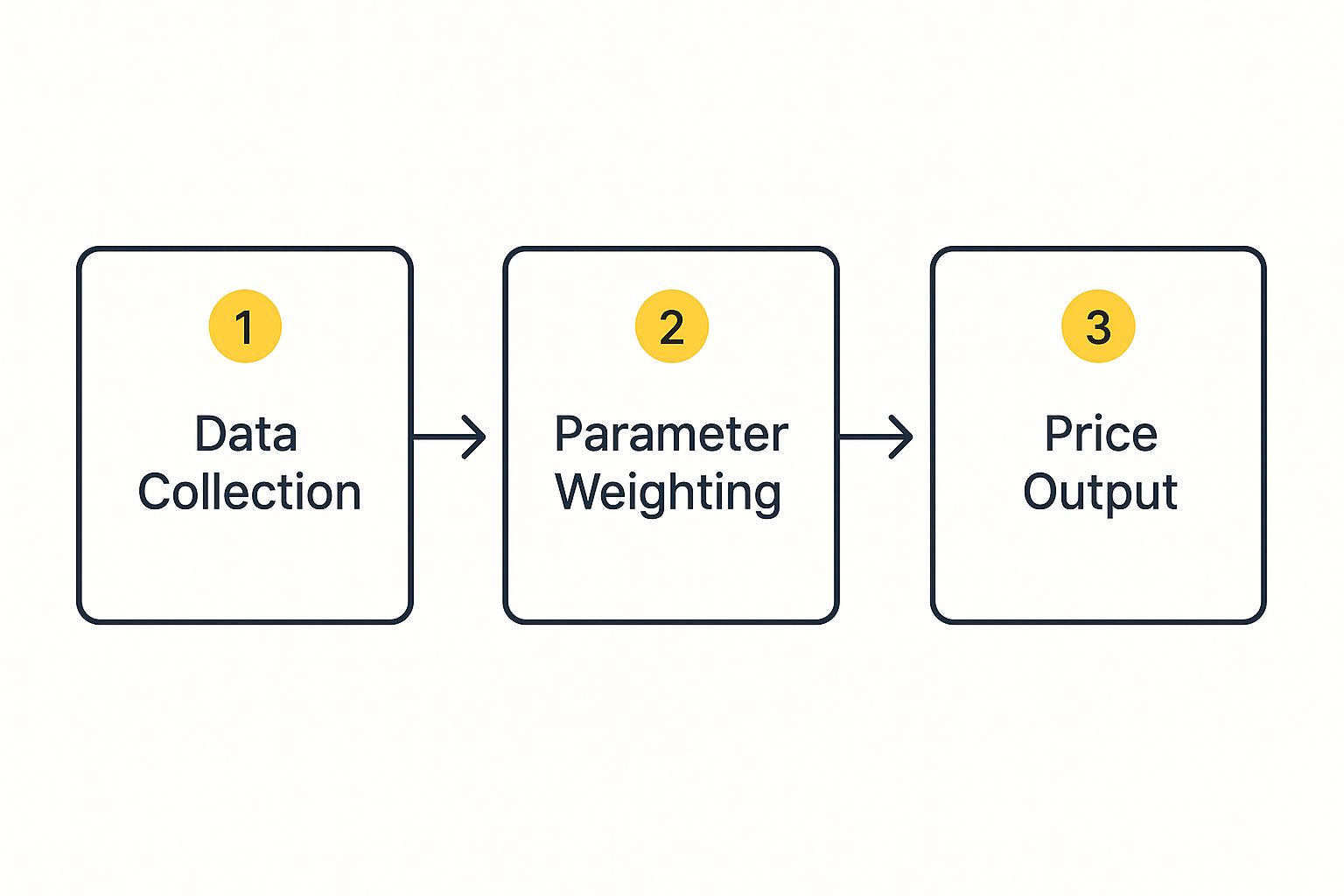
As you can see, the raw transaction data goes through a methodical process of being filtered, weighted, and analysed to produce a credible, standardised price for a specific area.
What’s really useful is that the system is designed to be a living document. It's not a static report that gets updated once a year. As new sales are registered with the authorities, that information feeds back into the system, keeping the price references fresh and relevant for anyone needing an accurate valuation.
Weighting Key Property Attributes
Now, the clever part is that the data isn't just thrown into a pot and averaged. An algorithm gets to work, analysing dozens of property characteristics to figure out how much they influence the final price. Each feature is given a specific "weight" based on how important it is to buyers in that particular market.
This sophisticated analysis looks at a range of factors, including:
- Location: This is, without a doubt, the most important factor. A flat in the heart of Casablanca's Gauthier district will have a completely different starting value than a similar-sized one in a quieter part of Rabat.
- Property Type: The system knows the difference between an apartment, a villa, a traditional riad, or a commercial shop. Each has its own distinct market and value.
- Size and Layout: The total square metres are obviously key, but the number of rooms and the floor plan also have a big impact on the final number.
- Age and Condition: The year of construction and the overall state of the building are crucial. A brand-new apartment will naturally command a higher price than an older one that needs a complete overhaul.
- Specific Features: Those little extras matter. Things like a balcony, a terrace, a private garden, a swimming pool, or even which floor an apartment is on are all factored into the calculation.
By giving different weights to these characteristics, the referentiel prix immobilier goes way beyond a simple price-per-square-metre calculation. It creates a much more detailed and accurate valuation that truly reflects what buyers in a specific neighbourhood are willing to pay for.
In the end, this detailed approach combines huge volumes of historical sales data with a fine-tuned analysis of what makes a property desirable. The result is a transparent and reliable benchmark, providing a solid foundation for any property deal in Morocco and taking much of the guesswork out of the equation.
Interpreting Regional Price Variations Across Morocco
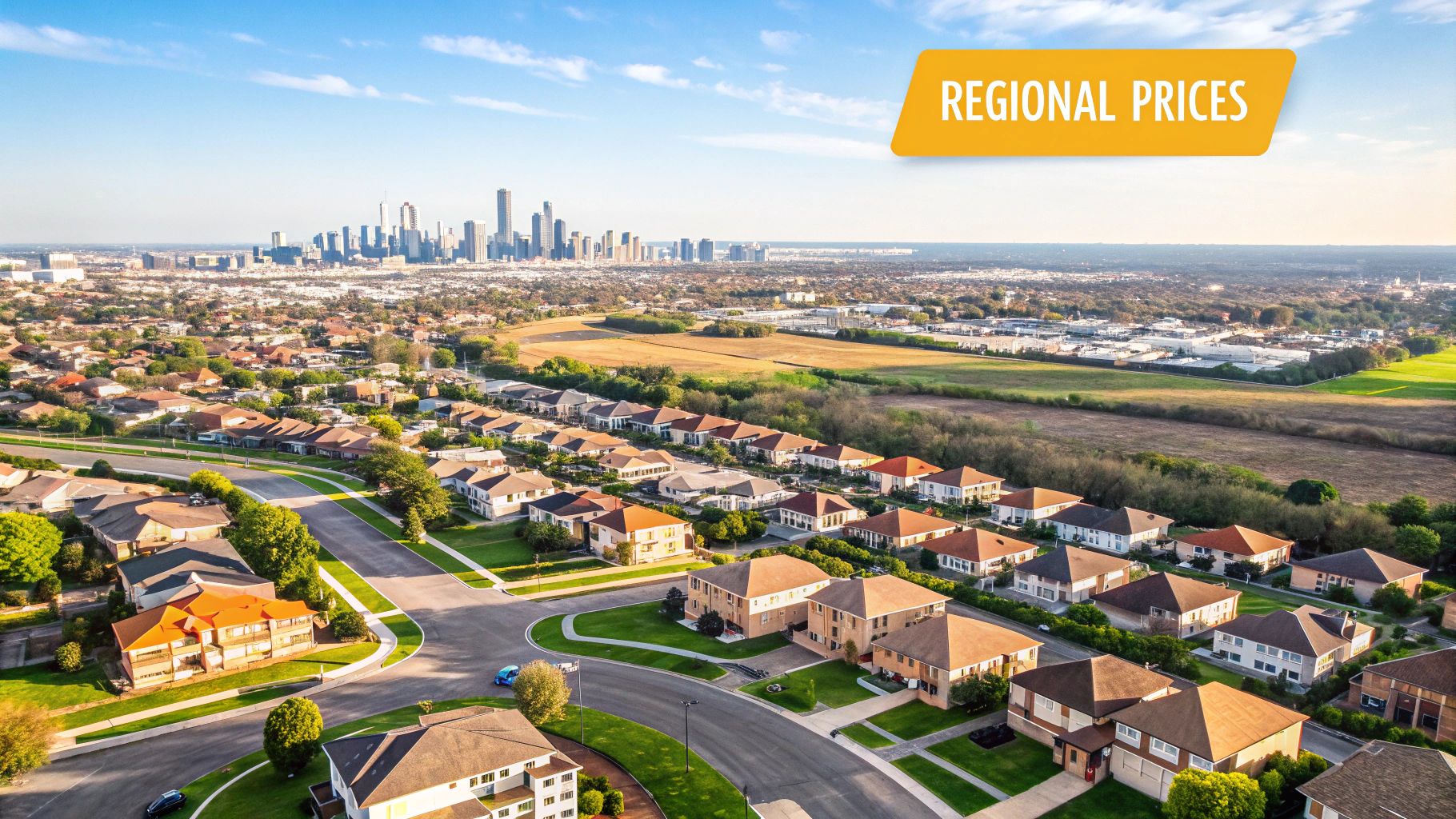
A quick look at the referentiel prix immobilier tells you something fascinating about Morocco’s property market: not all square metres are created equal. An apartment in the economic powerhouse of Casablanca can carry a vastly different value than a similarly sized property in the tourist-magnet city of Marrakech. Getting to grips with these regional differences is the first step to making a smart real estate decision.
Think of Morocco’s property market as a complex mosaic. Each city, and even each neighbourhood, is a unique tile with its own colour, texture, and value. The price reference is your guide—the legend that helps you decipher the story behind the numbers. It’s not just about a city-wide average; the data gets incredibly granular, showing you how property values can shift from one street to the next.
This level of detail is exactly what makes the reference so powerful. It gives you a real-time window into how local economic forces shape property values. For instance, you’ll see that a city with a buzzing commercial sector will naturally command higher prices than a quieter, more residential town.
Macro Drivers Shaping City-Wide Values
On a broad scale, a city's economic identity is the primary force setting its property price baseline. These big-picture factors establish the foundational value for real estate across an entire region.
- Economic Hubs: Take Casablanca, the nation’s economic engine. It sees consistently high demand from professionals and businesses, which naturally pushes property values up.
- Tourism Hotspots: In Marrakech, the market is fuelled by a constant flow of tourists and international buyers looking for holiday homes or rental investments. This creates a unique—and often premium—market.
- Administrative Centres: As the capital, Rabat benefits from stable demand driven by government employees, diplomats, and related institutions. The result is a remarkably resilient property market.
- Logistical Gateways: Tangier's strategic location and massive infrastructure projects, like the Tanger Med port, have turned it into a logistical powerhouse, attracting investment that has supercharged local real estate values.
These distinct economic personalities explain the broad strokes you see on the property map. A higher price in Casablanca often reflects its commercial muscle, while a premium in Marrakech is tied directly to its global appeal as a travel destination.
Micro Factors Influencing Neighbourhood Prices
Now, let’s zoom in. You’ll quickly notice that prices can vary dramatically even within the same city. The referentiel prix immobilier is brilliant for pinpointing these differences, which often come down to hyper-local factors that determine a neighbourhood's desirability.
A neighbourhood's prestige is a powerful, though intangible, asset. Proximity to reputable schools, green parks, modern shops, and good transport links can add a significant premium to a property's value—a premium that the official reference data will reflect.
It's also worth keeping an eye on market sentiment, as trends in one region can ripple outwards. While the following figures are for Metropolitan France, they have direct implications for Morocco. For example, by late 2023, the price of second-hand homes in the metropolitan area fell by 3.88% year-on-year—a real-term drop of 7.33% when accounting for inflation. This cooling trend, paired with a slowdown in construction, points to shifting demand that can certainly influence neighbouring markets. You can dive deeper into these European property price trends to understand the wider context.
By piecing together both the big-picture economic drivers and the small-scale neighbourhood details, the referentiel prix immobilier allows you to see far beyond a simple price tag. It helps you identify high-growth areas, find stable markets, and spot potentially overvalued locations, effectively turning raw data into actionable market intelligence.
A Practical Guide for Buyers and Sellers
https://www.youtube.com/embed/NQbGR7v2HXY
Knowing what the referentiel prix immobilier is and how it works is one thing. Putting it to work to your advantage during a real transaction—that’s where its real value shines. For both buyers and sellers, this official data can completely change the tone of a negotiation, moving it from a vague guessing game to a straightforward, fact-based discussion.
When you have a government-backed benchmark in hand, you gain a powerful advantage. It gives everyone a neutral, shared starting point, grounding the entire process in reality and paving the way for a fairer outcome for all.
For Property Sellers: Setting the Right Price
As a seller, your biggest hurdle is hitting that pricing sweet spot. Ask for too much, and your property could languish on the market for months. Price it too low, and you're leaving money on the table. Think of the referentiel prix immobilier as your most reliable compass for setting a competitive and realistic asking price right from the get-go.
Your first step should be to look up the reference value for similar properties in your immediate area. This provides a solid, objective baseline. From there, you can fine-tune your price based on what makes your property unique.
- Premium Features: If your home boasts a recent high-end renovation, a stunning view, or a private garden that’s a rare find in the neighbourhood, you can confidently list it above the reference value.
- Need for Updates: On the flip side, if your property needs some significant work or repairs, the reference helps you set a fair price that acknowledges the investment the new owner will have to make.
For Buyers: Negotiating a Fair Offer
For buyers, the price reference is your secret weapon in negotiations. Before you even think about making an offer, dive into the data to see how the seller's asking price stacks up. If it's floating well above the official reference value, you're in a great position to negotiate.
This allows you to frame your offer with solid logic. Instead of just saying the price feels too high, you can approach the conversation with facts. For instance: "I really appreciate the property's features, but the official referentiel prix immobilier for this street is X dirhams per square metre. My offer of Y is based on this benchmark." An argument backed by official data is always more persuasive.
The key thing to remember is that the reference isn't a rigid price ceiling or floor. It's a powerful anchor for the entire negotiation. It shifts the conversation from personal opinions to objective data, empowering both sides to land on a price they can both feel good about.
It's also smart to keep an eye on how bigger economic shifts can trickle down to local markets. National factors like interest rates and government incentives often ripple through the residential real estate market. For example, in late 2024, the Île-de-France region in France saw a 5.3% annual price drop in existing homes, with Paris's average price expected to hit €9,420 per square metre by February 2025. You can explore more about trends in French real estate on AdrianLeeds.com to see how these dynamics play out.
Navigating the Tax Implications
Finally, it's crucial for both parties to understand the tax rules. If a sale is officially declared for a price below the reference value, the tax authorities (DGI) have the right to intervene. They can reassess the transaction and require the buyer to pay registration taxes based on the official reference price—not the lower sale price.
This is a safeguard against under-declaration, ensuring every transaction is transparent and above board.
Using the Price Reference for Smart Real Estate Investment
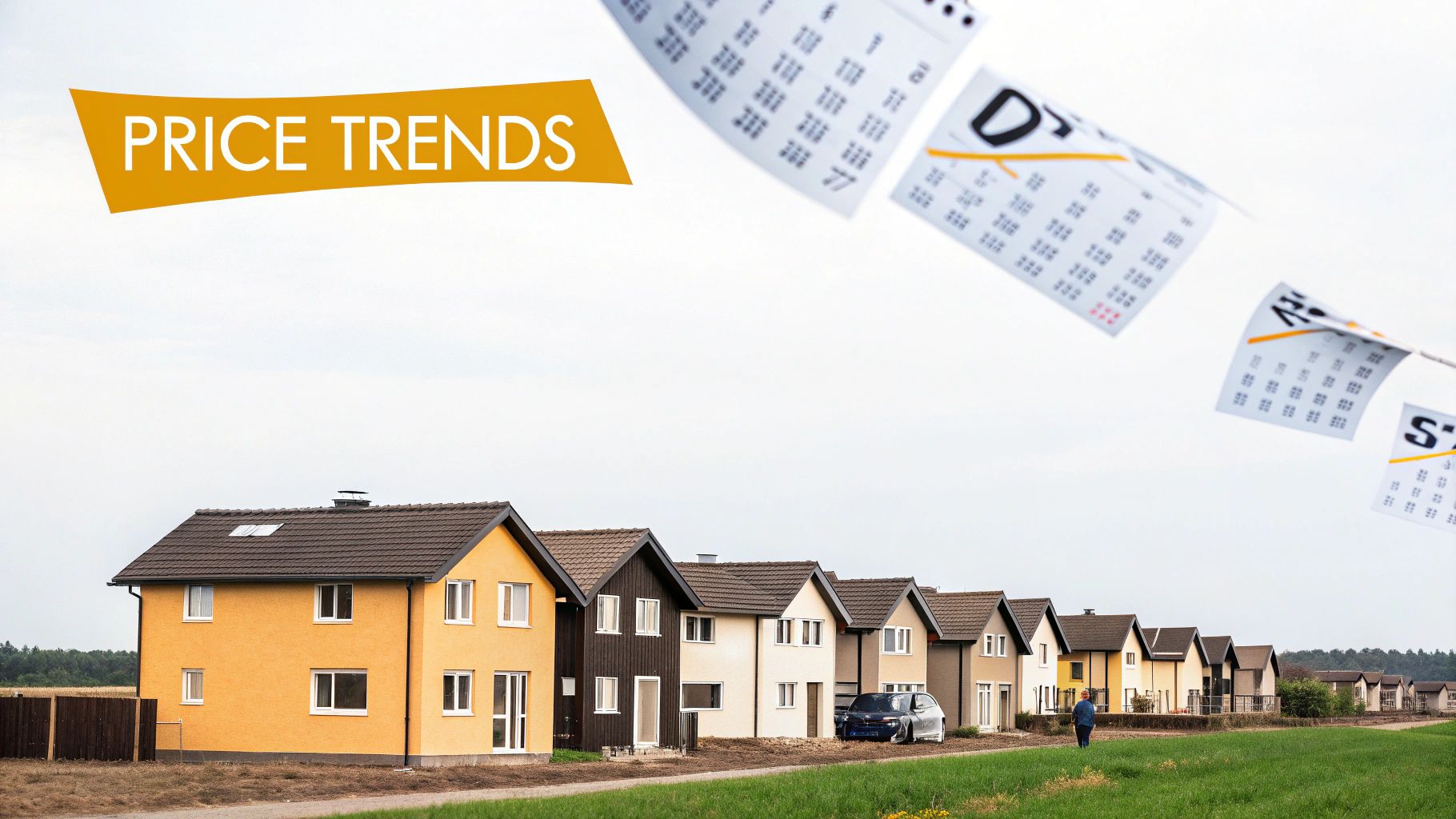
For any serious real estate investor, the referentiel prix immobilier is so much more than a simple tax benchmark. Think of it as a strategic compass, pointing you toward hidden opportunities and away from speculative guesswork. It lets you ground your investment strategy in hard data, completely changing how you analyse potential deals.
By tracking the trends in the reference data over time, you can spot neighbourhoods that are on the upswing long before they become the next big thing. This data-first approach is the key to finding those undervalued gems with real growth potential—the very cornerstone of a successful property portfolio.
The reference also gives you a solid, realistic starting point for calculating rental yields. When your purchase price is aligned with official market data, your financial projections become far more reliable, helping ensure your investment performs as expected right from the start.
Uncovering Investment Hotspots
The real magic of the referentiel prix immobilier for an investor comes from comparative analysis. When you start mapping out the reference prices across different districts or even between neighbouring cities, you can spot pricing anomalies and emerging trends that scream "investment opportunity."
Imagine this: one neighbourhood has flat prices, but the one right next to it is seeing a steady 5% annual increase in its reference values, thanks to a new tram line. That's a powerful insight. It tells you exactly where to focus your capital for the best chance of appreciation.
Keep an eye out for areas with these tell-tale signs:
- Consistent price growth: A steady, year-on-year climb in the reference value is a clear sign of strong, stable demand.
- A gap between rental demand and property values: If rents are high but reference prices are still moderate, future growth is often just around the corner.
- Planned infrastructure projects: New schools, parks, or commercial hubs can have a massive impact on a neighbourhood's value over time.
Conducting Data-Backed Due Diligence
In the world of property investment, you can't just take someone's word for it. The price reference is an impartial tool for your due diligence, giving you a quick and reliable way to validate a seller's asking price. It’s your first line of defence against over-inflated valuations.
An investor who walks into a negotiation armed with the referentiel has the upper hand. You can base your offer on concrete data, justify your position with confidence, and avoid overpaying—protecting your capital and maximising your potential return.
This data is also crucial for getting a handle on regional market dynamics. For example, recent analysis showed Lille's median property price reaching around €3,701 per square metre by late 2024, marking a 4% annual increase, while new builds shot up by 52%. This kind of growth, often fuelled by urban renewal projects, shows just how much local factors can influence value. You can find more detail in this insightful report on the French real estate market.
Ultimately, making the referentiel prix immobilier a core part of your strategy is what separates a casual buyer from a serious, strategic investor. It gives you the insight needed to build a resilient and profitable portfolio. For more on this, exploring why properties in Morocco are perfect for investment can offer some valuable market context.
Your Next Steps in the Moroccan Property Market
By now, you should have a solid grasp of the referentiel prix immobilier. We've pulled back the curtain to show it's not just a number for tax purposes, but a genuine tool for bringing much-needed clarity to the Moroccan real estate market.
You've seen how it's built on real data, why understanding local differences is so important, and how you can put it to work for your own goals. This benchmark is your ally, whether you're buying your first home, selling a family property, or scouting your next investment.
The real aim here is to shift from guesswork to informed decisions. When you use the referentiel properly, you replace that feeling of uncertainty with solid confidence, making sure your deals are not only fair but also financially smart.
Armed with this official data, you can now check asking prices against the market reality, walk into negotiations with more conviction, and get a much clearer picture of what a property is truly worth.
Your journey, whether you're looking at a modern flat in the city or exploring unique opportunities like the best riads in Tangier for your dream getaway, should feel far less daunting.
With these insights in your back pocket, you’re ready to navigate Morocco's vibrant property market with a clear head and a well-defined plan for success.
Frequently Asked Questions
When you're dealing with the référentiel des prix de l'immobilier, it's natural for a few specific questions to pop up. Let's walk through some of the most common scenarios to give you the confidence and clarity you need.
What If My Property Has Unique Features?
This is a big one. What happens when your home has something special that the standard reference price just doesn't account for?
Think of the official benchmark as your starting point, a baseline valuation. If your property has significant, value-adding features—say, a brand-new high-end kitchen, a stunning panoramic sea view, or a professionally landscaped garden—you absolutely have grounds to ask for a higher price.
The Bottom Line: The reference price isn't the final word. It’s a guide. If your property is above average, you need to prove it.
To justify your higher valuation, solid documentation is your best friend. Make sure you have:
- Professional photos that clearly show off the upgrades.
- All the invoices and receipts from any renovations or major improvements.
- A formal appraisal from a certified expert who can detail why these features add tangible value.
How Often Is the Price Reference Updated?
Another frequent question is about the data's freshness. The référentiel des prix de l'immobilier isn't a "set it and forget it" document. The DGI updates it periodically to keep pace with the market's natural ebbs and flows and reflect the latest sales data.
The update schedule can vary from one city to the next, but major reviews are generally carried out annually. This ensures the reference prices stay relevant. Before you get serious about any transaction, your first move should be to check the official DGI portal for the most current version for your specific area.
Can I Sell for Less Than the Reference Price?
Finally, sellers often ask if they're allowed to close a deal for less than the official reference price.
The short answer is yes, you can. However, there's a crucial detail to be aware of. If the sale price you declare is lower than the reference value, it could raise a red flag with the tax authorities.
In that situation, they have the right to review the transaction. They might decide to reassess the property's value themselves and could require the buyer to pay additional registration taxes based on the official reference price, not your lower agreed-upon price. It’s a mechanism to ensure fairness and prevent property value under-declaration for tax purposes.
Ready to navigate the Moroccan property market with an expert by your side? Contact Rich Lion Properties today for personalised guidance and seamless service. Visit us at https://richlionproperties.com to get started.
